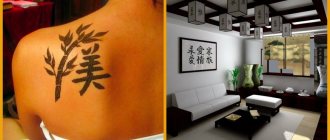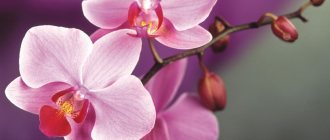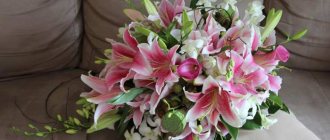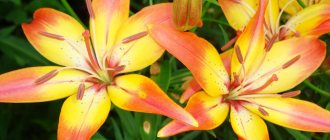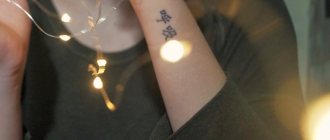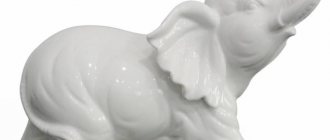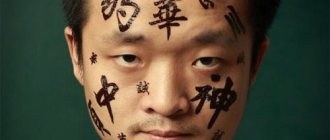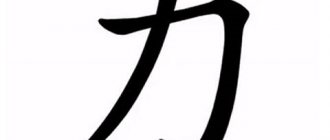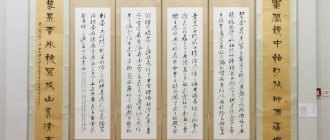If you've been learning Japanese for a long time, then it's likely that Japanese characters have become part of your everyday life and are not something outlandish. However, for a beginner or someone completely unfamiliar with Japanese writing, Japanese characters can evoke a lot of feelings, from complete misunderstanding of the meaning of these mysterious squiggles to intense curiosity.
If you see a hieroglyph, for example, as a tattoo or on someone's wall as a decoration, then it is likely that you will want to know its meaning. Well, it’s not just that a person chose this set of lines and sticks, which intricately adds up to a meaning accessible to a select few.
Eastern culture remains popular in Russia, and a large number of people strive to understand the mysterious eastern world.
For what purposes do people look for specific hieroglyphs?
Primarily for tattoos. A hieroglyph tattoo attracts the attention of others (it is likely that many people, having seen the tattoo, will want to know the meaning). A stuffed hieroglyph is an identifier of belonging to a secret for its owner, and can also tell others (if they know the meaning of the kanji) what the person with the hieroglyph pays attention to, for example, health, love or wealth, and in some cases all of this at once.
For a person of European culture, hieroglyphs carry an aura of mystery and a kind of magic. For the same reason, people buy talismans or amulets in the form of hieroglyphs and believe in their protection, trying to join Eastern wisdom.
Some people are fascinated by the magic of calligraphy . Beautiful writing of hieroglyphs is an entire art, which consists not only of using a brush competently, but also focusing your mind on the meaning of the hieroglyph, gathering all the power of the brush, drawing the treasured sign.
Another area of application of hieroglyphs is Feng Shui. This is an ancient Chinese teaching about the harmonization of space. It is believed that characters placed in the right place (for example, the Japanese character for “Wealth” in a wallet) attract what they mean. They contain deep meaning and are believed to have great power.
So, below you can get acquainted with the hieroglyphs that are in greatest demand, as well as the order in which they are written. Imagine the surprise of your friends when you can easily not only tell the meaning of a hieroglyph depicted, for example, on the hand of your interlocutor, but also read it.
Story
The Chinese character for “happiness” appeared with the advent of writing about a thousand years ago and initially had a slightly different meaning. According to the designs on ancient fortune bones, the "fu" sign was associated with the altar and the worship of the gods in the hope of receiving the blessings of heaven. The desire to achieve “fu” was reflected in ancient culture; the hieroglyph became the basis for numerous rituals and worship ceremonies.
The tradition of hanging a hieroglyph on the doors of houses is associated with the legend of Jiang Taigong - the god of gods, whose great mission was to assign corresponding positions to heavenly rulers. According to legend, Jiang Taigong lived during the Zhou Dynasty and was subordinate to the Supreme Heavenly Lord. The impetus for the emergence of such a custom was the request of Jiang Taigong’s wife to make her a goddess. To which the god of gods replied: “Since I married you, poverty has settled in my house. So be the goddess of poverty. Your domain will be where there is no happiness.” Having appointed his wife to a new position, Jiang Taigong introduced the tradition of hanging an image of a hieroglyph on the doors so that the goddess of poverty could never enter such houses.
Safety precautions for using the hieroglyph “Double Happiness”
Now read the safety precautions so that nothing slows down your luck. 1) Never hang this “Double Happiness” symbol in the bathroom or toilet, because... everything beneficial that will attract this hieroglyph will be washed down the pipe (symbolically, of course). 2) Do not hang this symbol in a dark closet, in a corner, on a balcony or in a passage corridor: in these places, it will not attract anything good, but will rather be “offended.” 3) The hieroglyph can be drawn on paper, on canvas, with paints or ink. Both the background and the colors can be of any color (except for gray and brown tones). But it is best for the background to be made in red, pink tones, and the hieroglyph itself to be yellow, gold, or orange. For example: my friend herself embroidered with yellow-golden threads on a red canvas, hung the embroidery in a frame, under glass in the living room, and everything is in order in her personal life.
Double Happiness
The Chinese symbol for happiness, 幸福, consists of two characters that can be used separately but still mean the same thing. Thus, the meaning of the character 幸 (xìng) is happy, prosperous, while the character 福 (fú) means happiness and prosperity.
Of particular interest is also the symbol 喜 (xǐ), which is translated into Russian as “joy”, “fun”. The double outline of the joyful sign turns into the hieroglyph “double happiness” - a symbol that gives harmony in marriage and the fulfillment of all desires associated with a prosperous marriage.
Rules for using Feng Shui hieroglyphs
- You should use only those Feng Shui hieroglyphs whose meanings you know well. If you do not know exactly its meaning, it is better to look for additional information or consult a Feng Shui specialist.
- The selection of a hieroglyph is carried out on the basis of logic. There are hieroglyphs that are similar in meaning, but have different purposes and directions of influence. The selection of a hieroglyph should exactly correspond to your tasks.
- To improve self-knowledge and personal development, hieroglyphs must be placed in their best sector. They should be used separately from activation talismans.
- Protection hieroglyphs especially need separate use and location away from various activating talismans.
What does the "fu" sign look like?
More interesting in this regard is the hieroglyph 福 (fú), which is a universal symbol, reuniting all the components of happiness: joy, pleasure, pleasure. The sign consists of two parts: left and right. The first means the altar to which people go for God's blessing, the second part in turn is divided into three more parts: the roof, the mouth, the field, being a reflection of abundance and prosperity.
The schematic representation of the roof means a house, the mouth means the person living in this house, the field is regarded as the source of food for the family. Thus, the hieroglyph “happiness” in ancient times meant God’s and heaven’s blessing. By honoring the gods and observing the laws established by heaven, a person deserves the right to housing and food. What else does a person need to be happy?
Signs filled with chi energy
There are other runic characters in the Chinese language: “love”, “happiness”, “luck”, “wealth”, “longevity”, “health”. Such symbols are often applied to furniture or the interior of rooms in order to attract corresponding benefits to the inhabitants of the house.
For example, the hieroglyph “love” promotes harmony and peace in love relationships, eliminates conflicts, and strengthens family ties. “Luck” ensures success in all matters, expands the horizons of possibilities, and contributes to business development. The hieroglyph is usually drawn on workplaces, office or study walls. “Wealth” attracts money, material wealth, increases income and profits, and creates appropriate energy in the home and office. The hieroglyph “longevity” can ensure long and happy years of life; it is usually applied to the walls of the bedroom. The symbol of “health” brings good health to all household members, excellent mood, and promotes the recovery of the sick. All these hieroglyphs, despite the benefits contained in them, are based on the most important and important symbol of “qi” - vital energy, which is the catalyst for all living things.
What are Feng Shui hieroglyphs?
Chinese character "Feng Shui"
Hieroglyphs in Feng Shui are a system of conventional ancient Chinese signs containing a certain semantic meaning. Among the many reinforcing elements, such as auspicious numbers, verbal wishes, Feng Shui hieroglyphs are the most symbolic and effective. Despite its brevity, their image contains great meaning. Their action and effectiveness are time-tested.
Hieroglyphs in the Feng Shui system are aimed at achieving harmony with the world and the environment by the person using them. This leads to an improvement in the life situation as a whole, harmonization of relationships with other people, achievement of certain life goals, protection from adverse events, and contributes to personal and spiritual growth.
Placement of the symbol of happiness
As mentioned above, there are two symbols for happiness in Chinese: “happiness” and “double happiness.” The hieroglyph “happiness” (photo below) is intended to evoke God’s blessing only for one person. The action of the sign is individual and local, that is, happiness is granted only in the desired area, and not in all at once. Therefore, having decided where exactly you want to achieve success and prosperity, draw a sign in the place that will help you find happiness.
And in order to live in abundance, draw a hieroglyph on the south-eastern side of the house and regularly mentally address it with a request to attract success and good luck to you.
The meaning of double happiness
Unlike the “happiness” hieroglyph, the power of the “double happiness” symbol is more powerful and effective. He is able to fulfill all the desires and undertakings of not only one person, but also a group of people united by one desire. To attract success in business and creativity, place the hieroglyph in the north of the room, and the result will not be long in coming. The image of double happiness in the southwest helps to strengthen friendship, acquire new friends and like-minded people. The symbol helps to conceive a child if you energize the bed, replenish your wallet if you put the hieroglyph “happiness” in it, attract new opportunities and implement ideas. The image of double happiness can be presented as a gift to relatives and friends. It is important to give it with sincere and pure intentions.
Japanese character for “love”
愛(ai). Perhaps one of the most popular hieroglyphs, especially among married couples. Helps attract true feelings. Not to be confused with 恋 (koi). In the first case, we mean love not only for the opposite sex, but also for nature, life, and art. In the second case - romantic love for a specific person, even to some extent manifested in the desire to possess.
The order of strokes of the character 愛:
Hieroglyphs on the body are a mirror of the soul
Various tattoos of Chinese and Japanese characters are extremely popular among people. Distinguished by their special beauty and unusualness, they carry a mysterious meaning, which, moreover, can influence the life and destiny of a person. Therefore, it is very important to understand the meaning of the design you are going to apply. A thoughtless choice of a hieroglyph can lead to negative phenomena and may not express what you wanted to say with this tattoo.
A “happiness” hieroglyph tattoo is usually placed on the arm or neck and brings all the best to its owner, improves his energy field, and promotes success in all matters and endeavors. In addition to this symbol, tattoos of the hieroglyphs “luck” and “wealth” are widely used as body designs. Only when combined correctly with each other do they acquire the desired meaning. When the order of their application changes, the symbols acquire a completely different meaning and lose their original purpose.
An image of the symbol of happiness can be:
- hang on the wall (north, southwest, southeast);
- apply to jewelry, nails;
- use as a talisman on clothing;
- draw on a wallet, mobile phone and other items;
- put in the workplace;
- apply in the form of a body design.
The hieroglyph “happiness” (tattoo or image) is best drawn with your own hand. When drawing, all your positive energy, all your aspirations and desires will be invested into it. In this case, he will actively attract happiness and success to you.
Japanese character for “health”
健康 (kenkou). It is the combination of two kanji that forms the word “health”. It is believed that the image of this hieroglyph helps to improve the well-being of its owner. Sometimes you can simply find the character 健, but separately it means “healthy.”
What else can you do with hieroglyphs?
In addition to tattoos, Feng Shui and talismans, Japanese characters can be used in the following cases:
- Use your favorite hieroglyph when creating a hand-made postcard. This will be a memorable gift with which you will express your feelings or wishes in an unusual way. The postcard will be especially valuable for those who are interested in martial arts.
- In addition to the postcard, a mug with a hieroglyph would be a great gift idea
- Writing on a T-shirt is much less risky than getting a tattoo. Moreover, it is much more pleasant to wear a T-shirt with an inscription, the meaning of which is close to your spirit, than to try with difficulty to find a thing with an inscription on which would suit you.
- Japanese-style interiors are very popular these days. Well, what is Japanese style without a hieroglyph? If you want to contemplate a Japanese symbol on the wall of your room, you can watch a video with calligraphy lessons and create a real masterpiece on beautiful paper or a bamboo napkin. Another option is to make a custom photo wallpaper or poster.
- For those who are fond of needlework (embroidery, beads, etc.), creating a pattern on a pillow or panel will be akin to calligraphy. The main thing is to choose a beautiful layout.
- If you are invited to a Japanese-themed party (or even a simple party), bring candy, but not plain candy. Wrap each candy with a wish in the form of a hieroglyph to the person who will receive this candy.
If you want to learn how to write the most popular Japanese characters, then remember the most important rule - kanji are always written in a strict sequence of strokes. According to one Japanese scholar, if you write a hieroglyph without following the sequence, then you are committing a violent act on it.
It is also necessary to pay special attention to the meanings of hieroglyphs, so as not to get into an awkward situation when meeting a native speaker or a person who understands hieroglyphs. It is better not to spontaneously search for the meanings of hieroglyphs on the Internet, but to contact a Japanese friend (if you have one) or an experienced Japanese scholar.
But, you see, just knowing a few hieroglyphs is not that interesting. Especially if you plan to seriously study the Japanese language, you will face many difficulties, which often become the reason for the fading of interest in learning the language. And all because many people simply do not know how to learn kanji correctly. But we have great news for you - you can learn how to effectively memorize hieroglyphs in our course “Effective techniques for memorizing hieroglyphs.” Thanks to these activities, you will be able to predict not only the sequence of features even in hieroglyphs that are unfamiliar to you, but also the meaning and even the reading! There are not very many places in the group, so hurry up before all the basics are covered without you! You can find out more and purchase the course here.
Hieroglyphs were and remain to this day a beautiful and fascinating type of writing that can be mastered and improved endlessly.
Want to learn more about hieroglyphs?
Then sign up for a free course on effectively learning Japanese characters
Did you manage to write down the hieroglyphs given above? Please share in the comments.
Blessing of the sky in the sign of "fu"
Every person from birth strives for good luck, happiness and wealth, fearing troubles and misfortunes.
But not everyone turns out to be worthy of these benefits. In Chinese culture, there is a clear relationship between moral principles and God's blessing. Everyone is equal before heaven, regardless of social status and origin. And they favor only those who perform good deeds and deeds, observing the moral principles established by God. Kind-hearted people sooner or later acquire divine blessings, receiving wonderful and effective help in all matters. As Sun Simiao, a physician who lived during the Tang Dynasty, said: “Good fortune is the product of the accumulation of good deeds, and misfortune is the result of accumulated evil.” Good will certainly attract happiness and good fortune, while evil will inevitably entail a series of misfortunes and troubles.
The hieroglyph “happiness”, being a symbol of goodness, prosperity and divine blessing, cannot guarantee the owner of all these benefits if his heart is filled with evil and cruelty. The lucky sign "fu" means self-improvement, faith in God and the desire to do good deeds.
Sign activation
Only its owner must activate the sign. The hieroglyph may not work if it is placed under the mattress of the newlyweds without their knowledge. But a hieroglyph can bring good luck to a spouse, even if only his wife made the talisman.
When making a sign, it is better to be in a good mood, saying mantras or wishes to yourself.
The moment of installation of the talisman is important. During this ceremony, you should always think about your dream and recite the mantra of good luck. Installing a sign will be its activation. On the day when this happens, it is important to accumulate positive energy, not to do bad things, and not to wish evil upon even random people in passing.
The Chinese believe that harmony and prosperity come knocking on the door of those who do good deeds.
